Spike cap mushrooms are widespread across North America and found in conifer forests. They look pretty unique, with a wedge-shaped body and bright yellow stem base. There are approximately 10 spike cap mushroom species (Gomphidius) in North America, but that may change in the near future. All the species are edible but usually aren’t foraged because of their slimy texture and bland flavor.
- Scientific Name: Gomphidius
- Common Names: Spike caps
- Habitat: On the ground with conifer trees
- Edibility: Edible but not choice
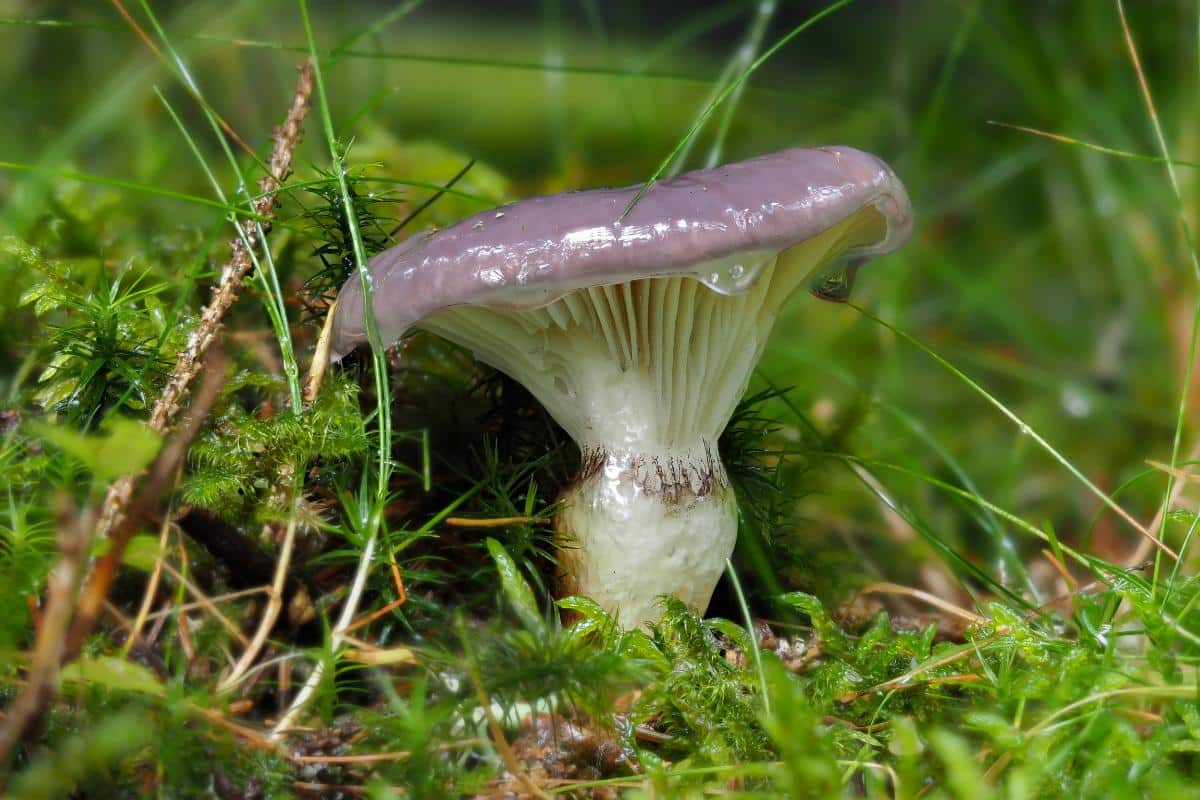
Jump to:
All About Spike Cap Mushrooms
These mushrooms are part of the Gomphidiaceae genus. They get their common name from their rounded caps that resemble a child’s hat and wedge-shaped body that looks like a spike. Spike caps are part of the overarching bolete order, even though they have gills. Most boletes have pores instead of gills.
Spike caps form special partnerships with conifer trees and grow near pine, fir, and spruce species. Scientists initially thought they were purely mycorrhizal, but recent research suggests they might be parasitic on other bolete mushrooms. Spike caps share several traits with their bolete relatives, especially with the genus Suillus. Both groups prefer coniferous environments and often have slimy cap surfaces.
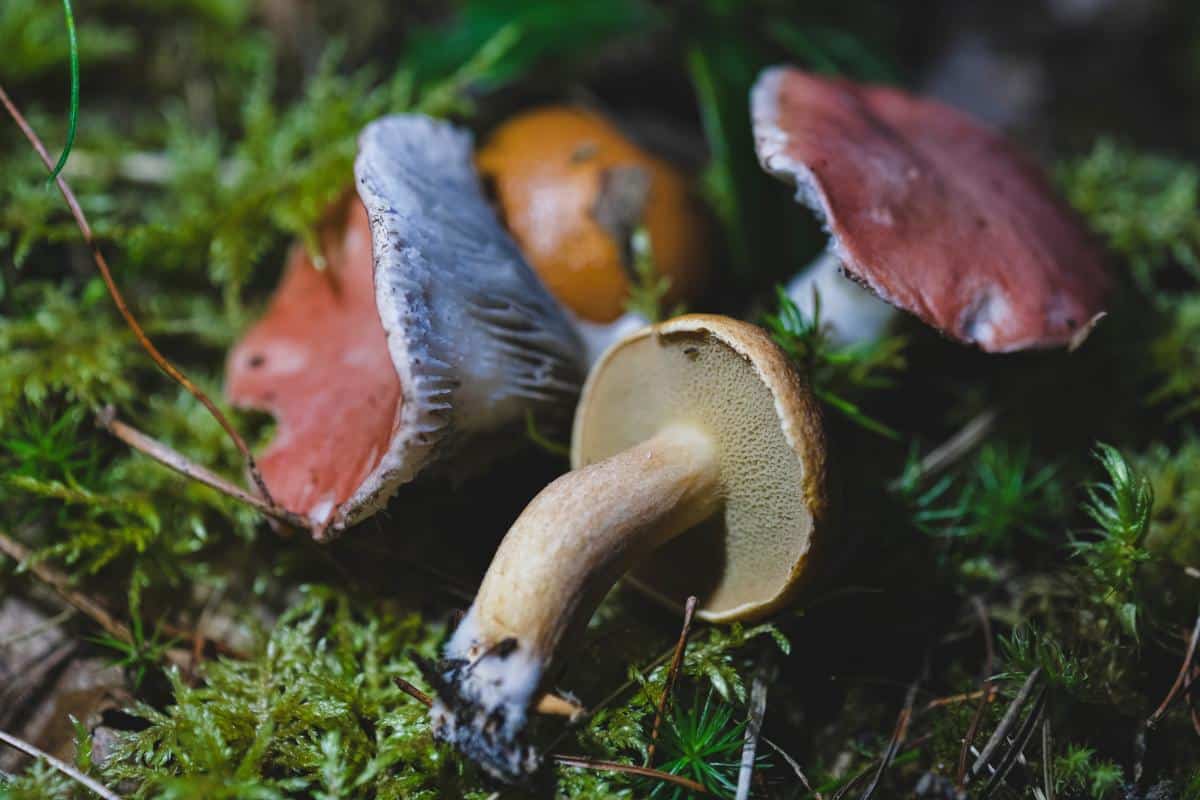
The genus name comes from the Greek word ‘gomphos,’ which means “plug” or “large wedge-shaped nail.”
Spike caps have several distinctive features:
- A cap ranging from 1⅛ to 4¾ inches in diameter
- A slimy or sticky cap surface that becomes more noticeable in wet weather
- Widely spaced, decurrent gills that darken with age from their initial whitish color
- A stem with a whitish top and distinctive yellow base
- A glutinous veil that covers young specimens and may leave a slimy ring around the upper part of the stem.
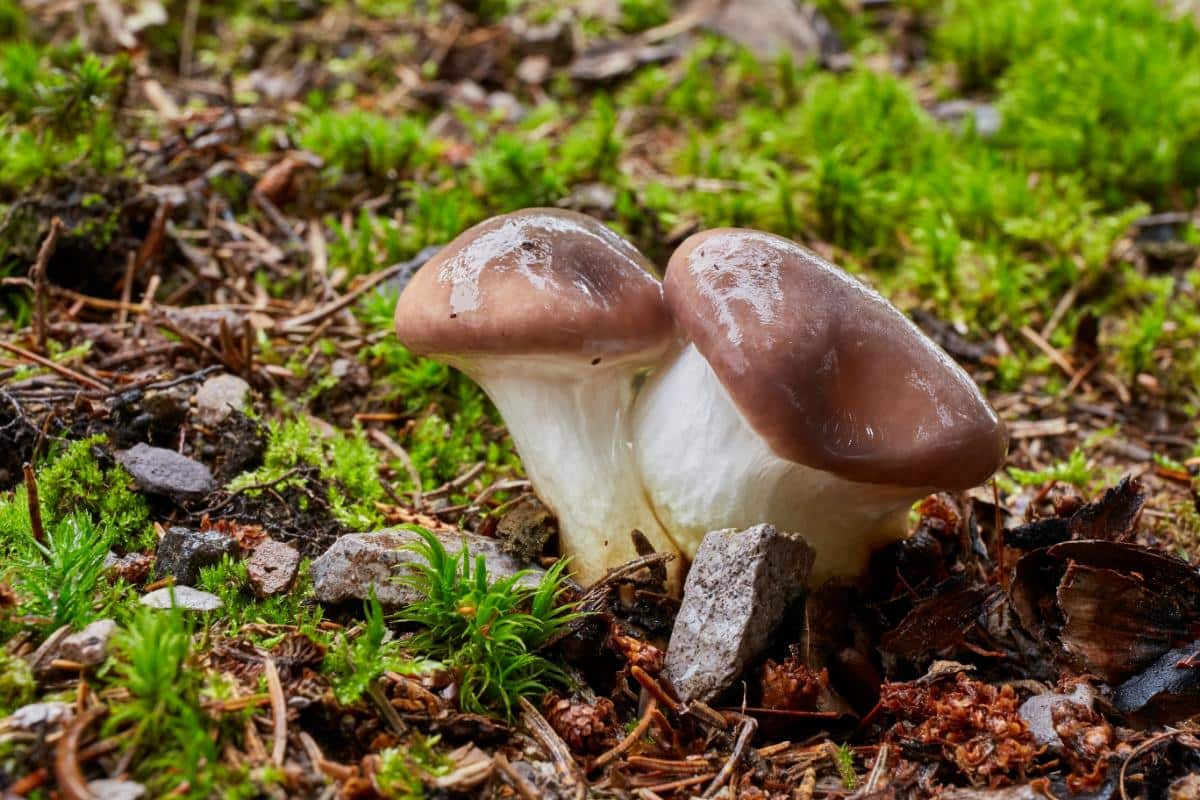
Spike Cap Mushroom Identification
Season
Spike caps appear in the summer and fall in most areas. In places with warm climates, they may also show up in winter.
Habitat
Spike caps grow in coniferous forests with spruce, pine, or fir trees. They appear as single specimens or scattered groups and sometimes grow in small clumps. They always grow on the ground, never on trees or from wood. Spike caps primarily grow at high elevations, up to 9,600 feet. They fruit in both natural woods and in conifer plantations.
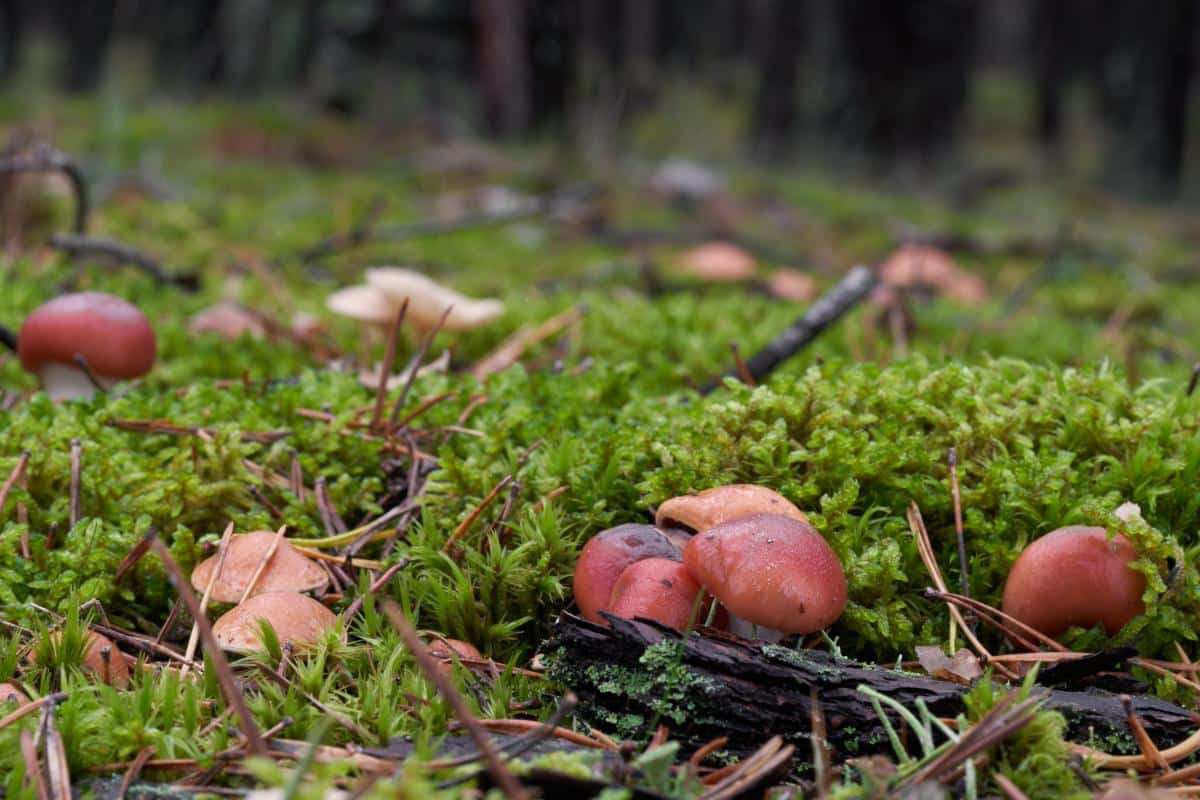
Identification
Cap
The cap of a spike cap mushroom measures between ¾ and 3⅞ inches wide. When the mushroom is young, the cap is covered in a very thin, slimy casing. As the mushroom grows, it breaks through the veil. The surface of the cap remains slimy or sticky, especially in wet weather. The cap starts out cone-shaped or rounded but flattens as it ages. The edge of the cap is often rolled under, especially when young.
They range in color from wine-red to reddish-brown, orange-brown to yellow-brown, dark purple to brownish-gray, or grayish-violet with blackish markings. The cap often has radial streaking patterns.
Gills
The gills are decurrent – running down the stem – and are widely spaced. Their texture is waxy. Young specimens have whitish or ochraceous buff gills that darken over time. The gills turn blackish as the spores develop in maturity.
The thin slimy veil that covers the cap also covers the gills when the spike cap mushrooms are young. As the mushroom grows, the veil breaks apart. There may be remnants of it hanging from the edge of the cap or gills and on the stem.
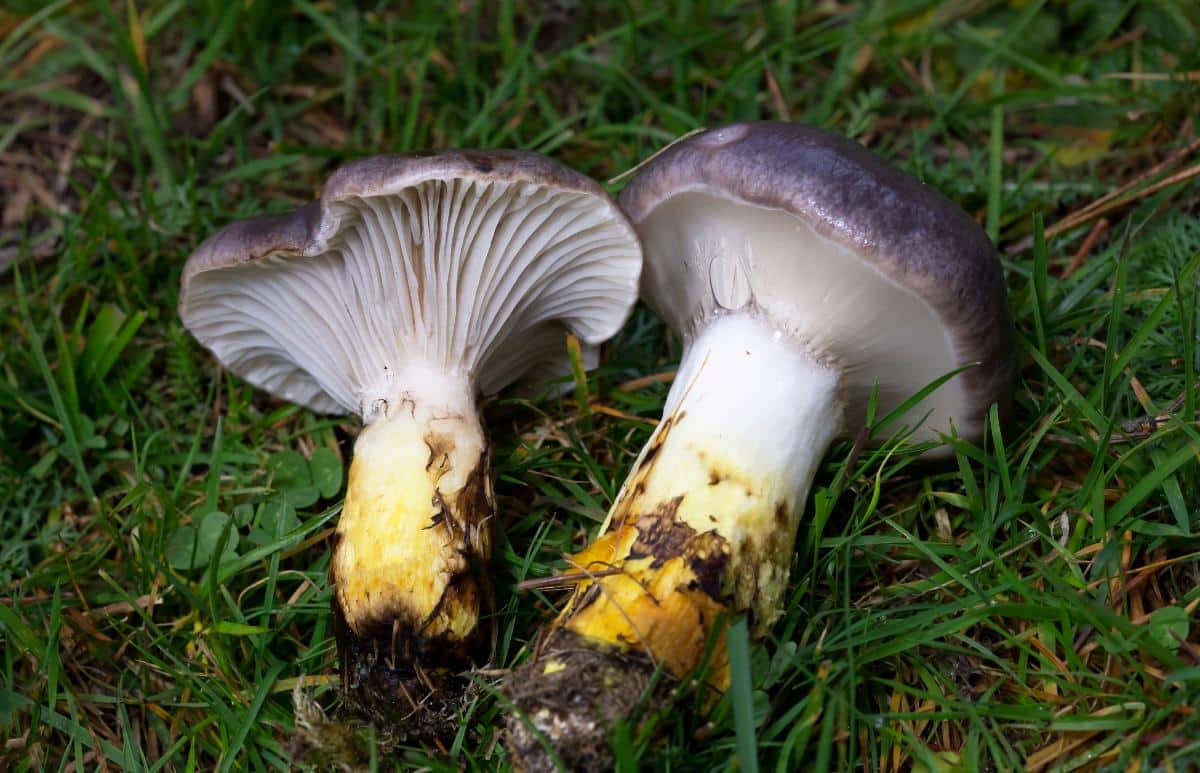
Stem
The stem grows between 1 to 6 inches long and ⅛ to ¾ inch thick. The stem’s most distinctive trait is its color pattern: white at the top that changes to yellow at the base.
Young mushrooms might show traces of a partial veil that creates a thin, fibrous ring on the stem’s upper part. The stem is smooth to slightly fibrillose and can become slimy in wet conditions.
Flesh and Staining
The flesh is white and may stain blackish when handled or with age. The lower part of the stem is bright yellow.
Smell and Taste
Most species do not have a distinctive smell or taste.
Spore Print
Dark gray to almost black.
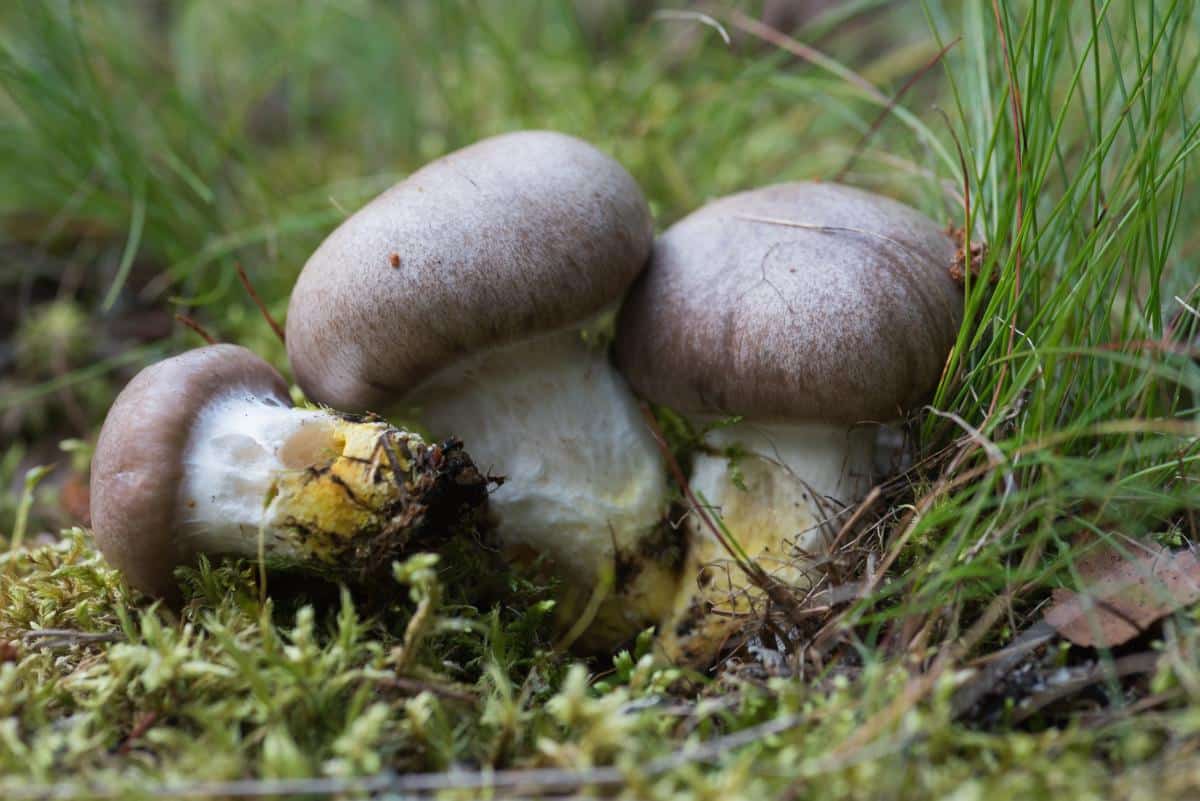
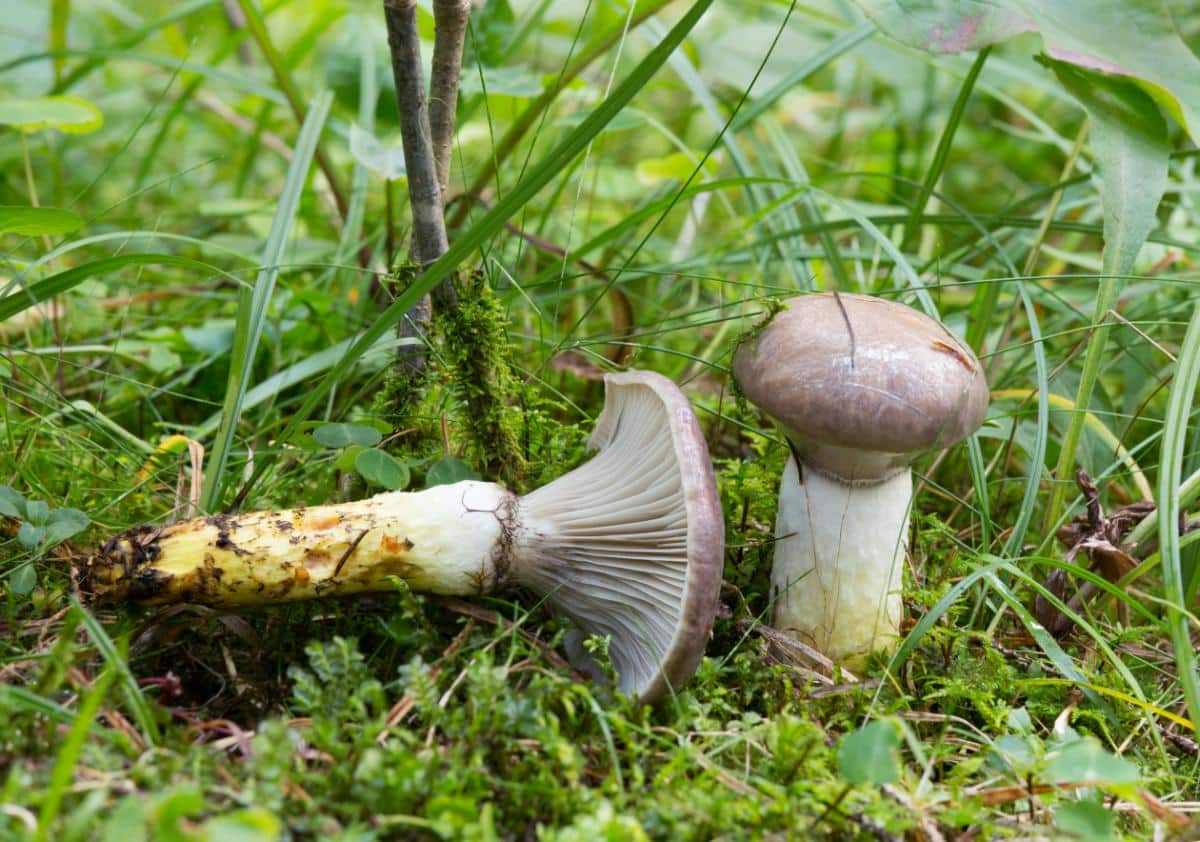
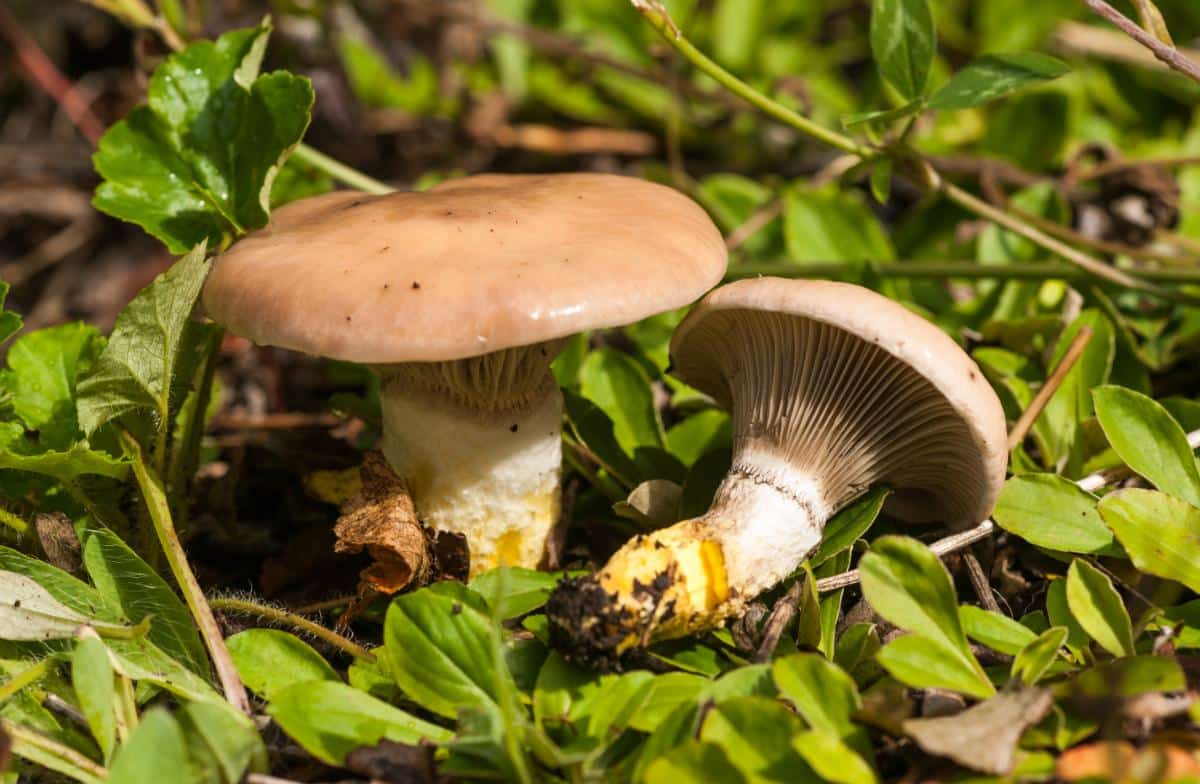
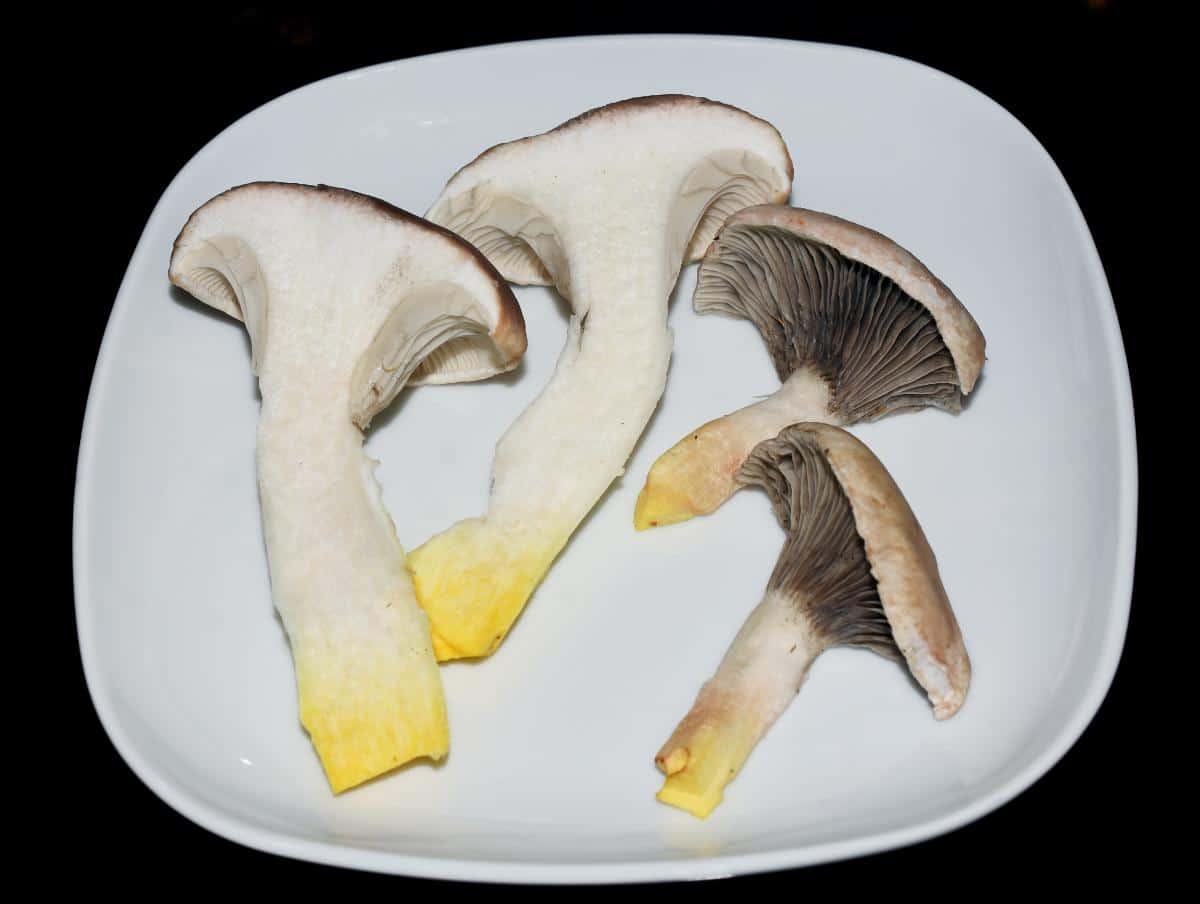
Common North American Spike Cap Species
Slimy Spike Cap/Glutinous Gomphidius (Gomphidius glutinosus)
*This species may actually be a species complex.
The slimy, glutinous cap of this mushroom measures 2 to 5 inches in diameter. The cap is initially rounded but later flattens with age. It ranges in color from grayish-brown to pinkish-brown to purplish-gray. Its stem is 2 to 4 inches tall and white to yellowish. When young, it often has a glutinous veil across the gills that leaves a ring-like zone around the stem. The lower half or quarter of the stem is bright yellow. The gills run down the stem, are widely spaced, and start out pale before turning grayish-black as the spores mature.
This species grows with conifer trees, particularly firs and spruces. It is more common in northern montane regions. It grows singularly, either alone or in scattered groupings. The singular growth pattern is one way to tell it apart from similar species, which tend to grow in clumps or small clusters.
The slimy spike cap is edible but not highly prized. While some foragers collect it for consumption, its slimy texture and mild flavor make it less popular than other wild mushrooms.
Interesting Fact: G. glutinosus is a fungus that can absorb and concentrate elements like cesium at levels more than 10,000 times higher than normal. This ability makes it useful for cleaning up areas that have been contaminated with radioactive cesium-137.
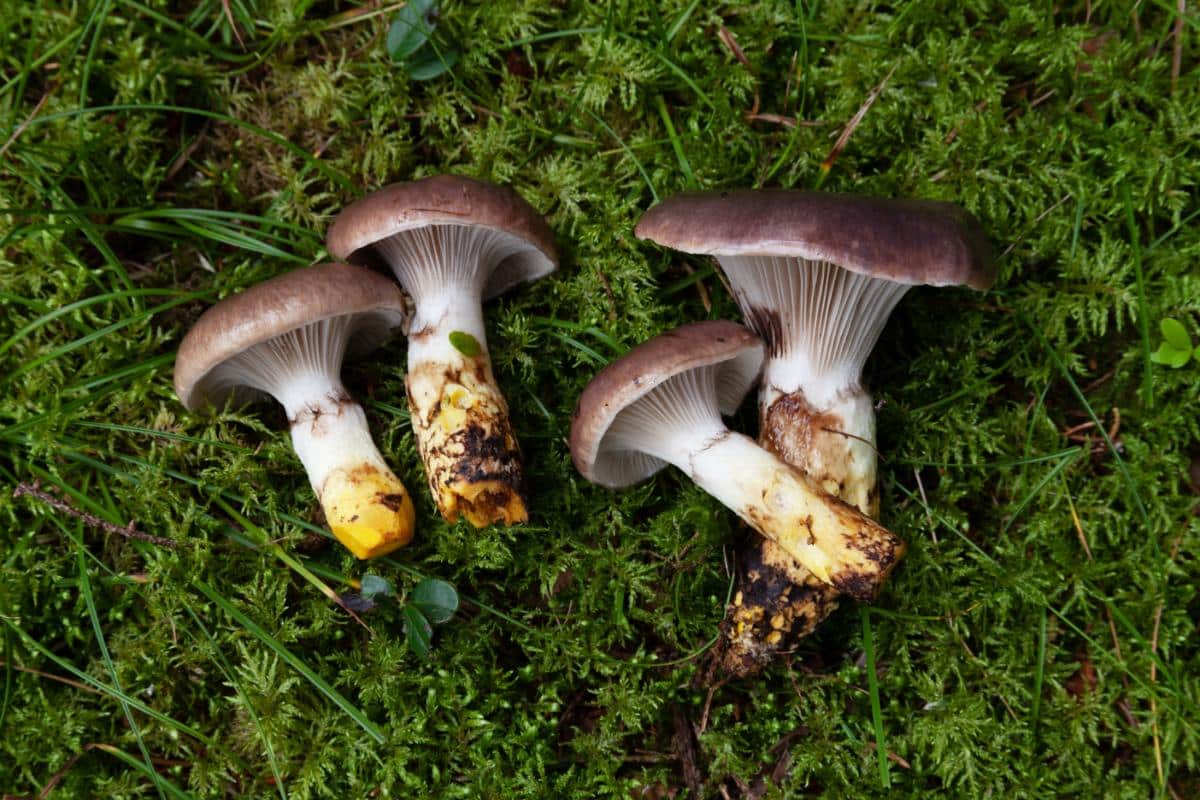
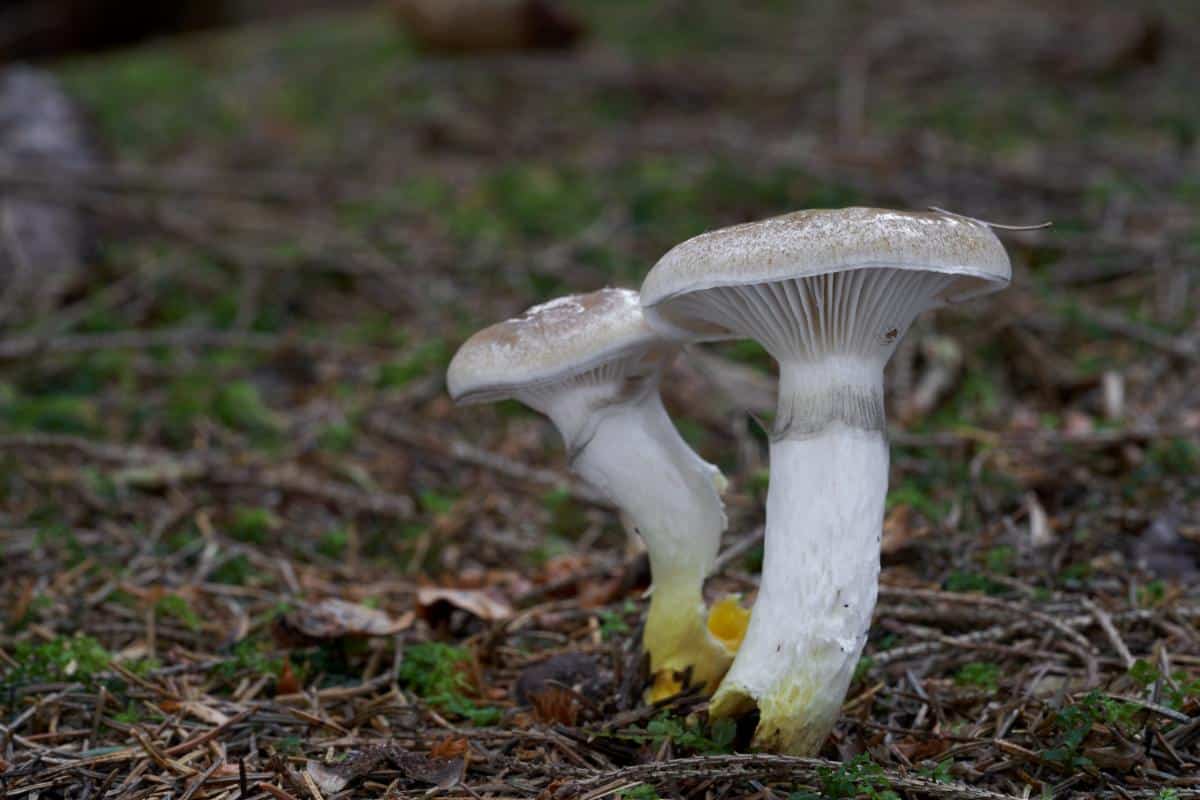
Oregon Spike Cap/Oregon Slime Spike (Gomphidius oregonensis)
The Oregon Gomphidius is found on the West Coast, including the Pacific Northwest, California, and Montana. This mushroom has a slimy, sticky cap that ranges from 2 to 6 inches in diameter. The cap color varies widely from reddish-brown to grayish-pink to almost black when mature. The cap often has a darker center. As the mushroom matures, the cap flattens and may develop a slightly depressed center.
The gills are whitish buff when young and then mature to gray. The stem is typically 2 to 4 inches tall. The upper portion is whitish, and the lower half is pale yellowish. The stem may darken with age — it bruises blackish when handled. A key identifying feature is the presence of a glutinous veil that leaves a slimy ring on the stem.
Oregon spike cap mushrooms are edible but not highly prized. They’re not toxic, but their slimy texture and mild flavor make them unappealing to many foragers.
These spike cap mushrooms grow in conifer forests and prefer Douglas fir. Unlike other spike caps, the Oregon spike cap often grows in clusters with their stems fused at the base. They will grow singularly, though, too.
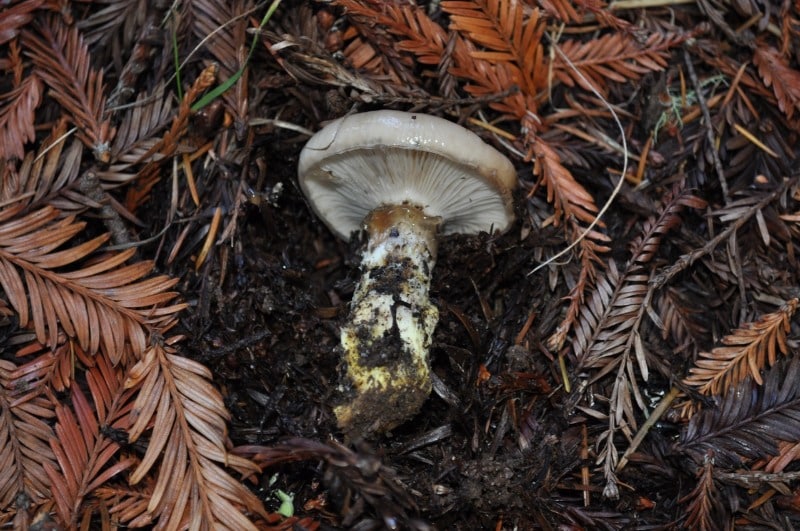
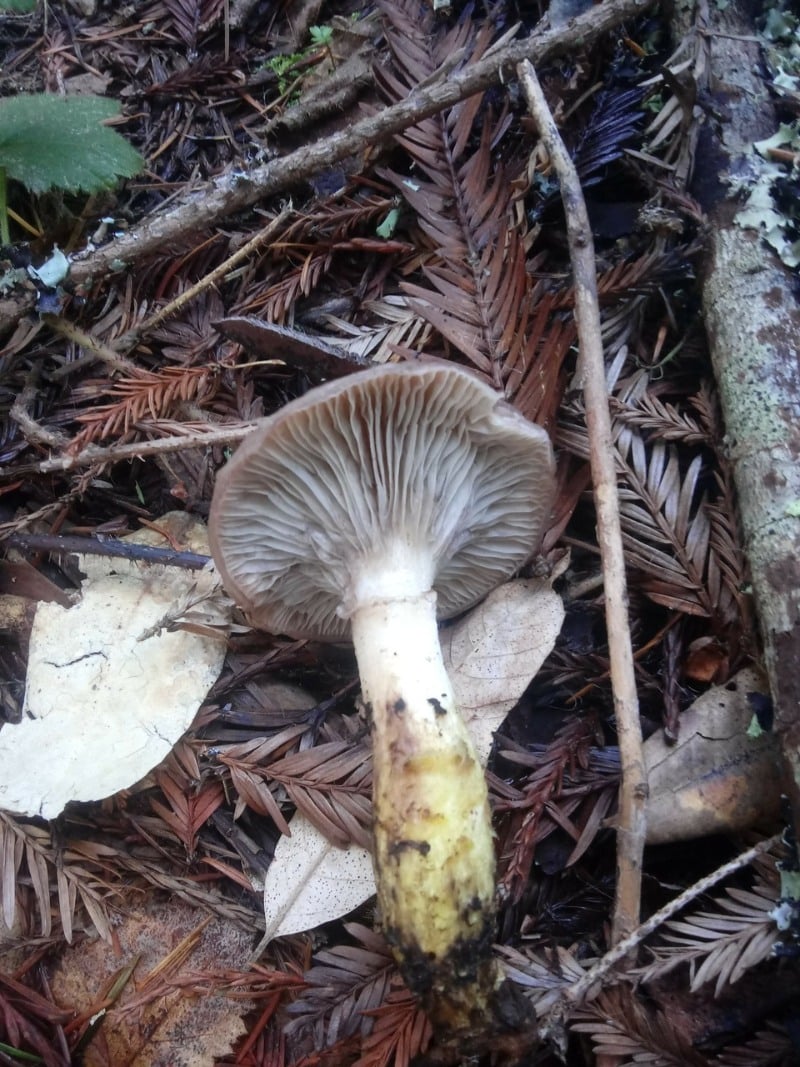
Pink spike-cap/Rosy Spike Cap (Gomphidius subroseus)
The Rosy Spike-cap is characterized by its pinkish to salmon-colored cap, which can measure 1.5 to 4 inches in diameter. The cap is initially rounded, then becomes flat or slightly depressed with age. The surface is sticky or slimy surface when moist. Its stem is typically 2 to 4 inches tall and has a pinkish hue that darkens towards the base. The gills are decurrent and widely spaced. They start whitish but turn grayish-pink to brownish as the mushroom matures.
The stem is white on the top portion and bright yellow on the lower half. The stem bruises blackish with handling and age. Around the upper half of the stem, there may be a slight slimy ring, which is a remnant of the slime veil.
This species grows with conifers, especially in Douglas fir forests. It grows alongside Suillus lakei, commonly known as Matte Jack. It is widespread but uncommon in eastern North America. It is much more common in the Pacific Northwest and the Rocky Mountains.
While Gomphidius subroseus is considered edible, it’s not highly prized due to its slimy texture and mild flavor.
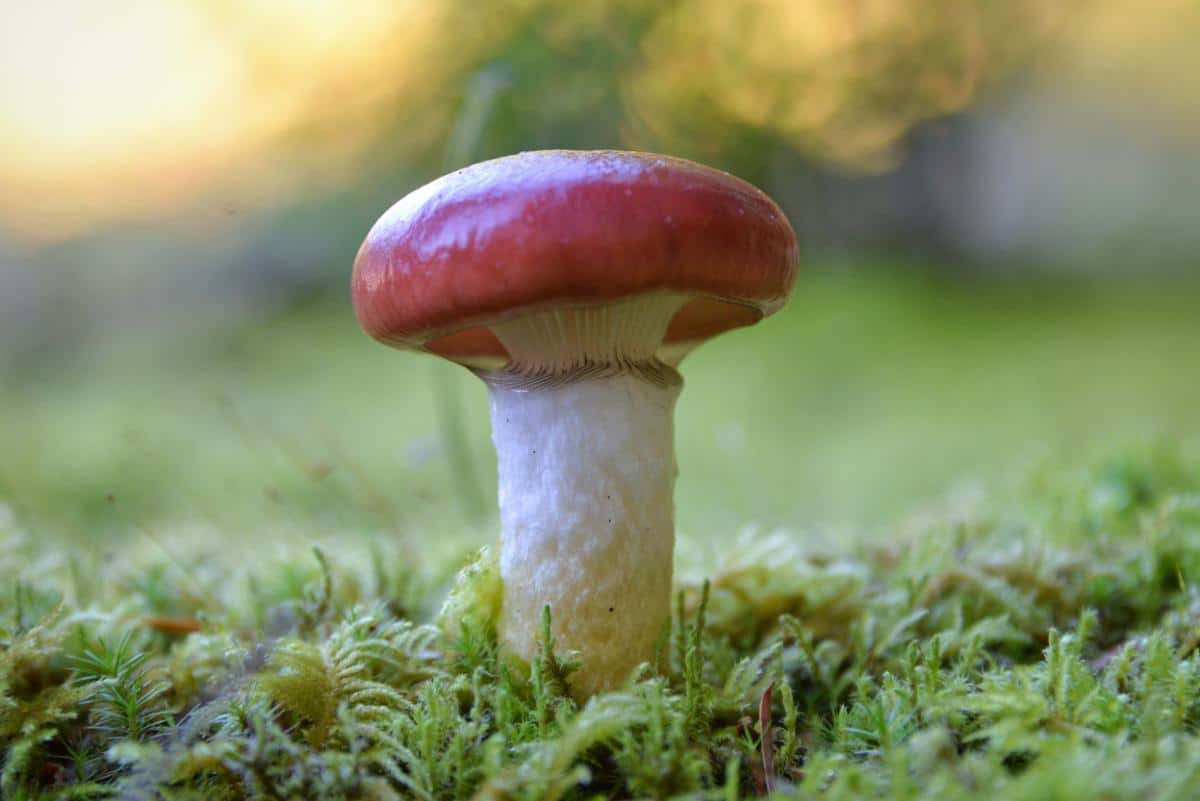
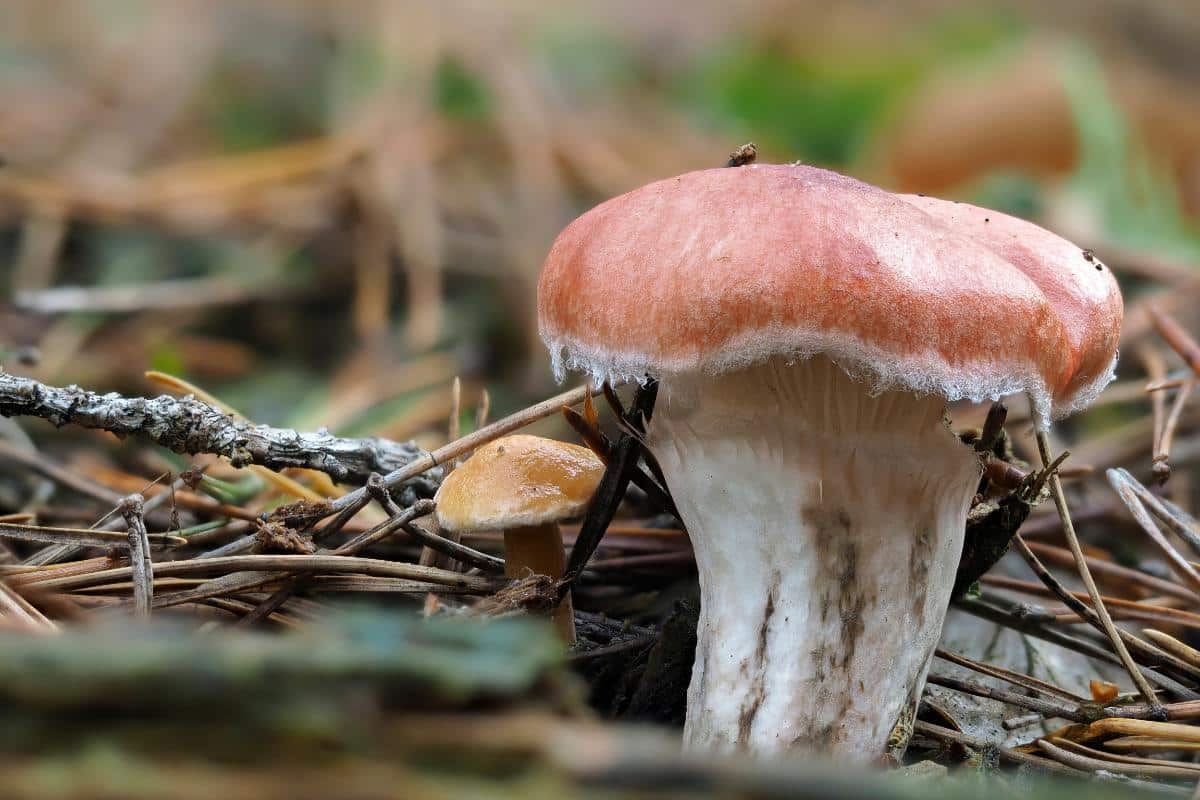
Large Gomphidius (Gomphidius largus)
This species is very similar to G.glutinosus except much bigger. It can grow up to 8″ wide. The cap starts out rounded and then flattens with age. It often has a slightly depressed center and a slimy or viscid surface when moist. Its color ranges from reddish-brown to grayish-brown, sometimes with a purple tinge. The stem is thick, measuring about 2 to 4 inches, and is whitish or pale yellow, sometimes with reddish stains. The gills are decurrent, widely spaced, and have a distinctive gray-to-blackish color due to the dark spores.
This species is extremely rare. It only occurs in North America and has only been documented a handful of times.
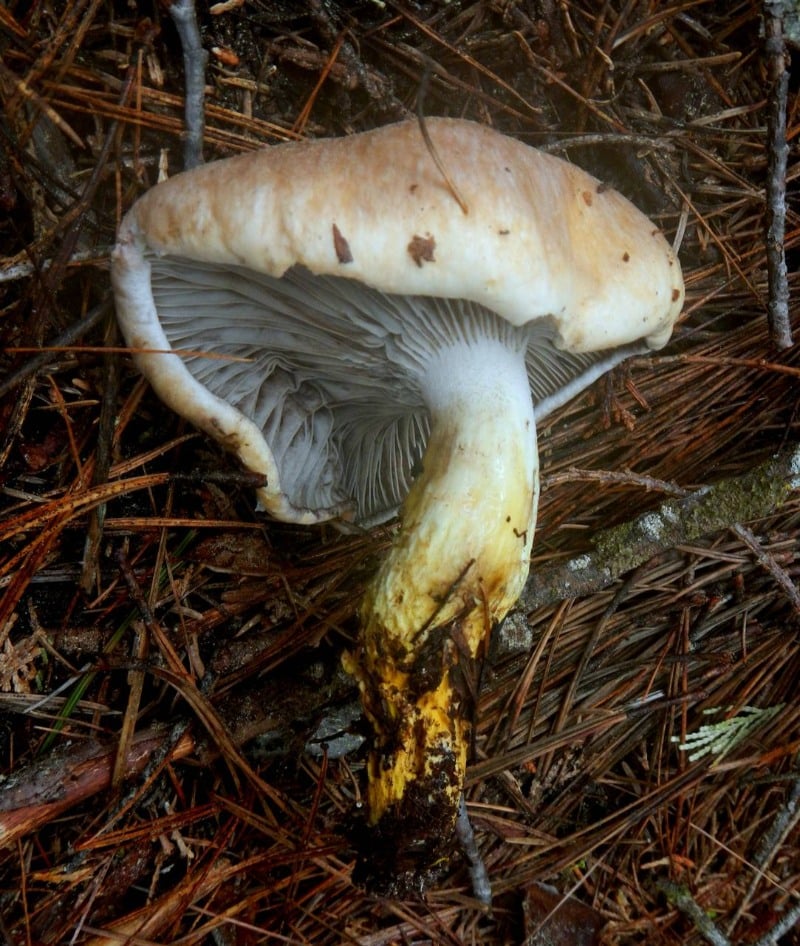
Spotted Gomphidius/Larch Spike Cap (Gomphidius maculatus)
The spotted spike-cap typically measures 1.5 to 4 inches in diameter and is initially rounded before flattening with age. The cap’s surface is slimy and sticky when moist. It is pale grayish-brown to reddish-brown with darker spots or blotches, giving it its “maculatus” (spotted) name. The stem ranges from 1.5 to 3 inches in length and is a similar color to the cap. The lower stem is covered with fibers that are smoky yellow to purplish black.
There may be a ring around the upper stem, a remnant of the slimy veil that covered the gills when young. The gills are decurrent and widely spaced. They start out pale before darkening to a grayish-black as the spores mature.
There are two key features that set this species apart from other spike cap mushrooms. The flesh of this species blackens when cut, and the gills blacken when handled. And the lower half of the stem is not yellow.
The spotted Gomphidius grows widespread across North America, but it is uncommon. It only grows at high elevations and has been found in mountain ranges across the country.
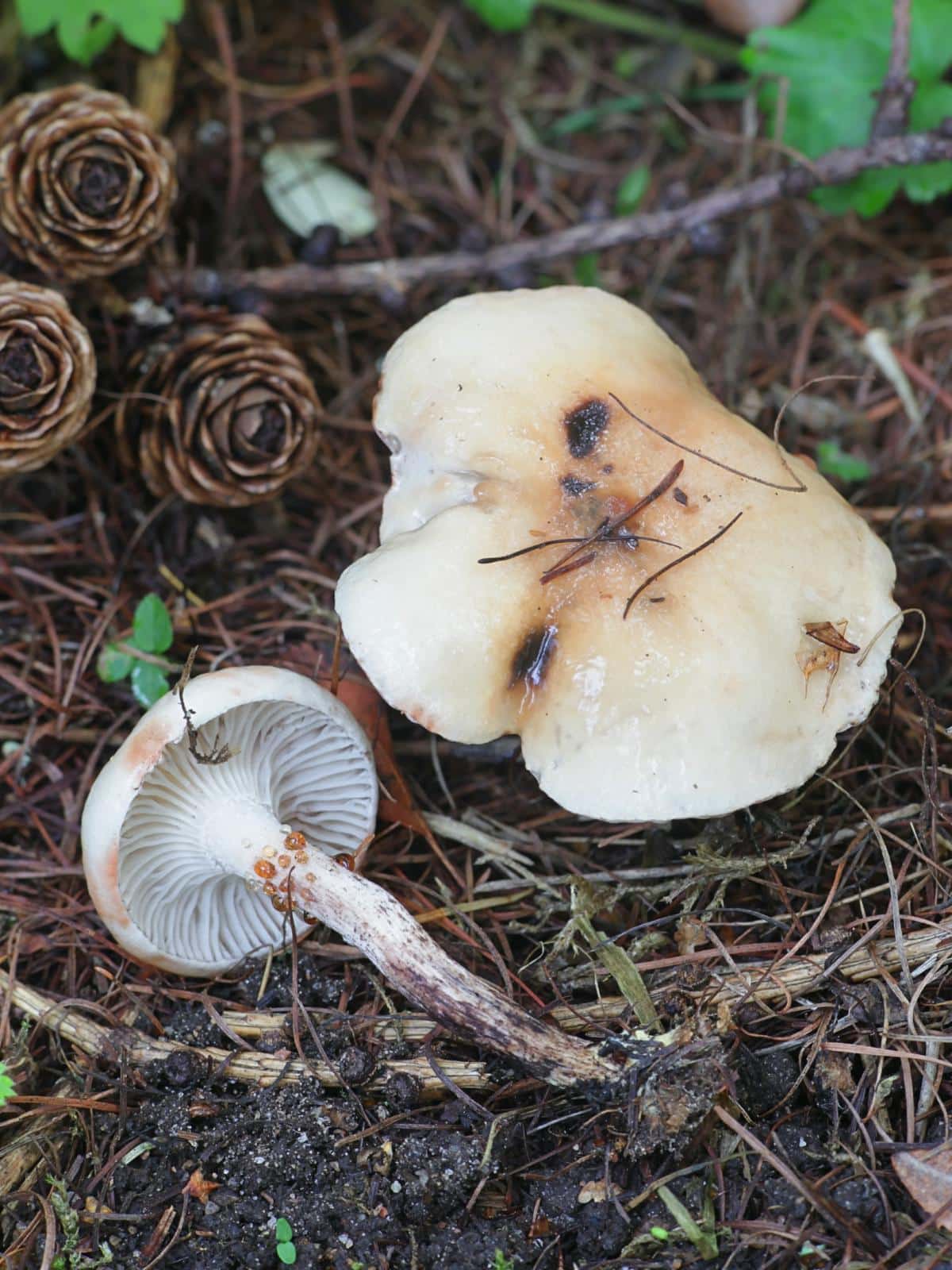
Blackening Spike Cap (Gomphidius nigricans)
The cap of this spike cap typically measures 1.5 to 4 inches in diameter. It starts out rounded and flattens with age. It has a smooth, slimy surface that ranges from grayish-brown to nearly black, often darkening further as it matures. The stem is 2 to 4 inches tall with a pale yellowish base that gradually darkens upwards. Gills are decurrent, widely spaced, and initially pale gray, turning black with age. A key identifying feature is the blackening of all parts of the mushroom when bruised or as it ages.
This species grows in eastern North America and extends west to Michigan. It grows in association with eastern pine trees. Its cap starts white or yellowish and changes to shades of pinkish or browns before blackening completely. This is an uncommon spike cap mushroom species.
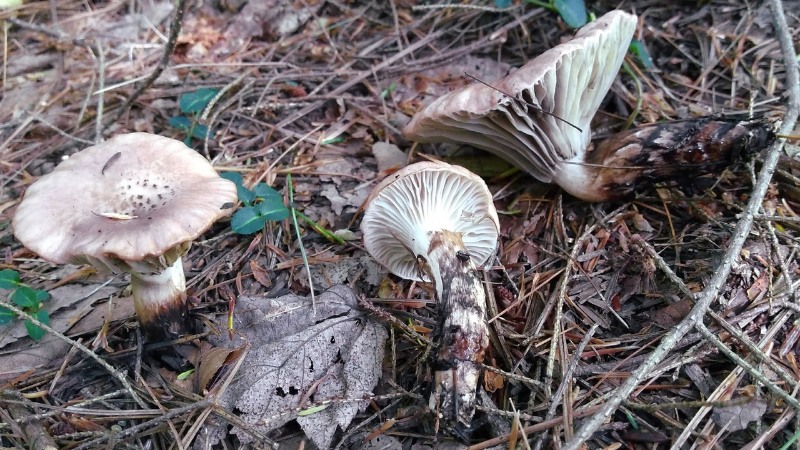
Smith’s gomphidius (Gomphidius smithii)
This spike cap grows in coniferous forests, particularly associated with pine trees. The cap is typically 1.5 to 4 inches in diameter. It starts out rounded and then flattens with maturity. It often develops a central depression as it matures. Its surface is slimy and smooth. The color ranges from pinkish-brown to reddish-brown, sometimes with darker streaks radiating from the center.
The gills of this mushroom start out white and then mature to dark gray. The stem is 2 to 4 inches tall. The upper part of the stem is whitish, while the lower half is lilac to brownish. It is not bright yellow at the base like other spike cap mushrooms. But, with age, it may develop a slight yellow tinge at the base of the stem. The stem discolors blackish with age and handling.
It grows with conifers, particularly among young Douglas Fir forests. It is found on the upper West Coast and in the northern Rocky Mountains.
The species can be distinguished from similar Gomphidius species by its brownish stem base, relatively small, dull brownish lilac cap, and association with pine trees.
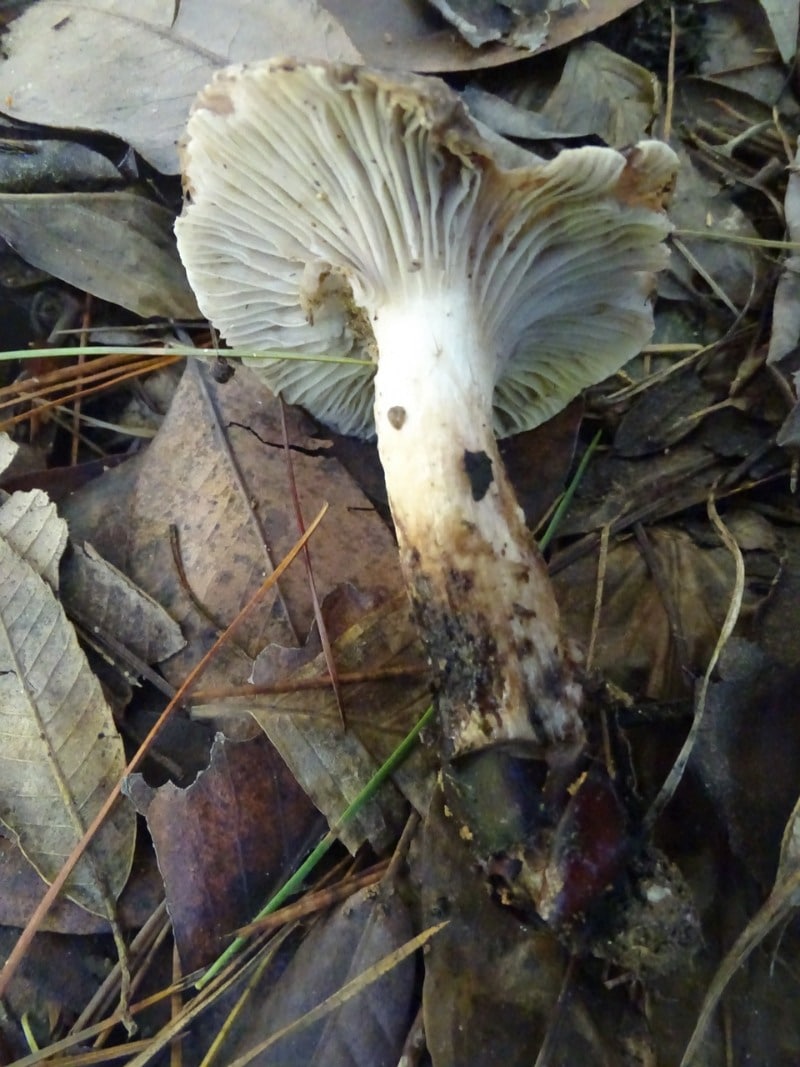
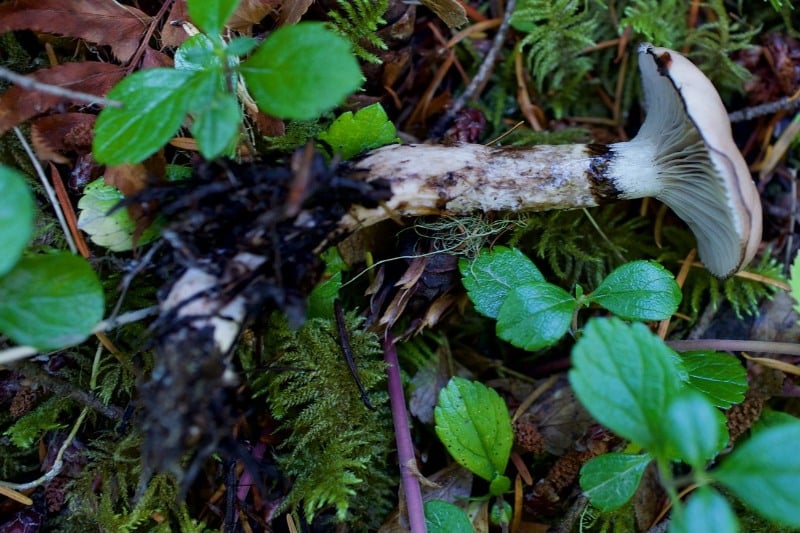
Spike Cap Mushrooms Lookalikes
Suillus species
Many Suillus species have brownish or yellowish caps that are also slimy. From above, they can look like spike cap mushrooms. And, they often grow right alongside spike caps (in association with, or parasitizing on). It’s extremely common to see Suillus boletes in the same patch as spike cap mushrooms. However, it is easy to quickly tell the difference. The main difference shows up under the cap – spike caps have gills, while Suillus species have pores.
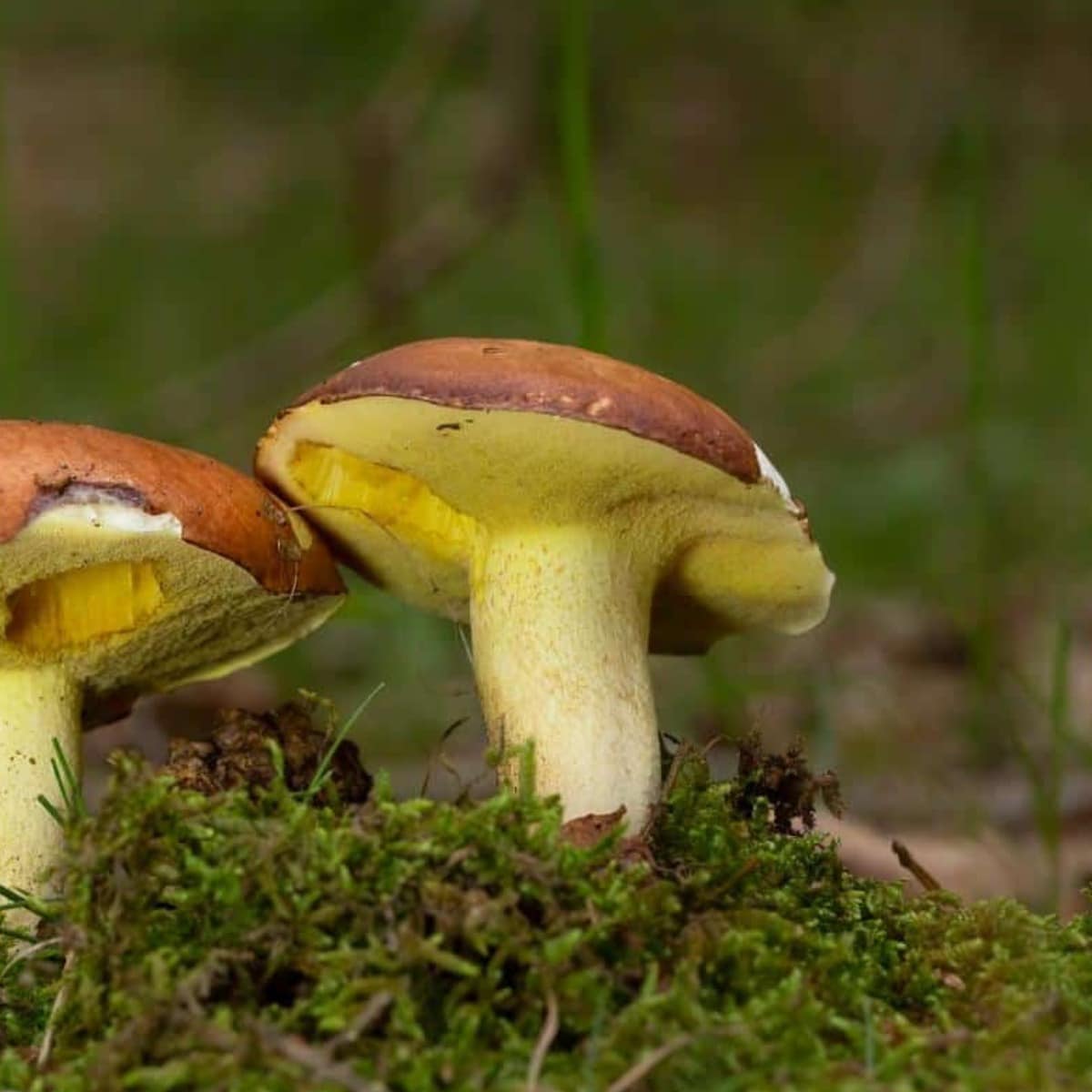
Wood Waxes/Waxy Caps (Hygrophorus & Hygrocybe species)
These are whitish to brownish, slimy-capped mushrooms that often share the same habitat as conifer trees. They also grow in broadleaf forests, but when found with conifers, it can be confusing. Many waxy caps have slimy or sticky tops and, from above, look a lot like spike caps.
Hygrophorus species are characterized by their waxy or greasy-looking caps and gills. The caps are typically convex to flat, often with a central depression. They range in color from white to various shades of yellow, orange, red, or brown. The gills are thick, widely spaced, and decurrent (running down the stem). A distinctive feature of Hygrophorus is the waxy texture of their gills, which can often be peeled away from the cap flesh.
In contrast, the colors of Gomphidius caps tend to be more subdued, ranging from grayish to brownish or reddish-brown. Gomphidius stems are usually more robust and may have a slimy or viscid surface, often with remnants of the partial veil. Hygrophorus species typically have smooth stems that are often the same color as the cap or paler.
There are over 100 Hygrophorus species around the world, some of which are edible. If you’re ever in doubt, do a spore print. Hygrophorus species have a white spore print, while Gomphidius spore prints are dark gray to black.
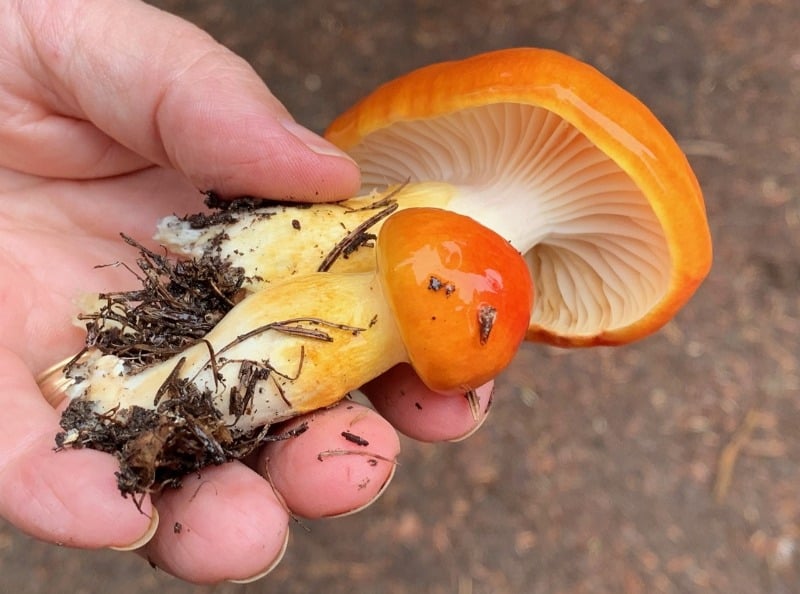
Webcaps (Cortinarius species)
Cortinarius and Gomphidius both belong to the order Boletales. While they share some similarities, these two groups have several key physical identification differences. Many Cortinarius species are toxic, so be extra careful with this identification if you intend to eat your finds.
Cortinarius species are characterized by their cortina. This is a cobweb-like partial veil that covers the gills of young mushrooms. This cortina often leaves a rusty-colored ring or remnants on the stem as the mushroom matures. Cortinarius mushrooms typically have dry caps ranging in color from brown to purple, red, or even bright yellow. Though, there are some very slimy specimens, too. Their gills are attached to the stem and often start out pale, changing color as the spores mature. The spore print of Cortinarius species is usually rusty brown.
In contrast, Gomphidius species lack the cortina found in Cortinarius. Instead, spike caps have a slimy or viscid cap surface, which can be various shades of brown, gray, or even pinkish. Their gills are decurrent, meaning they run down the stem. And they are often “waxy” in texture. Spike caps also usually have the bright yellow stem base which easily sets it apart from webcap mushrooms.
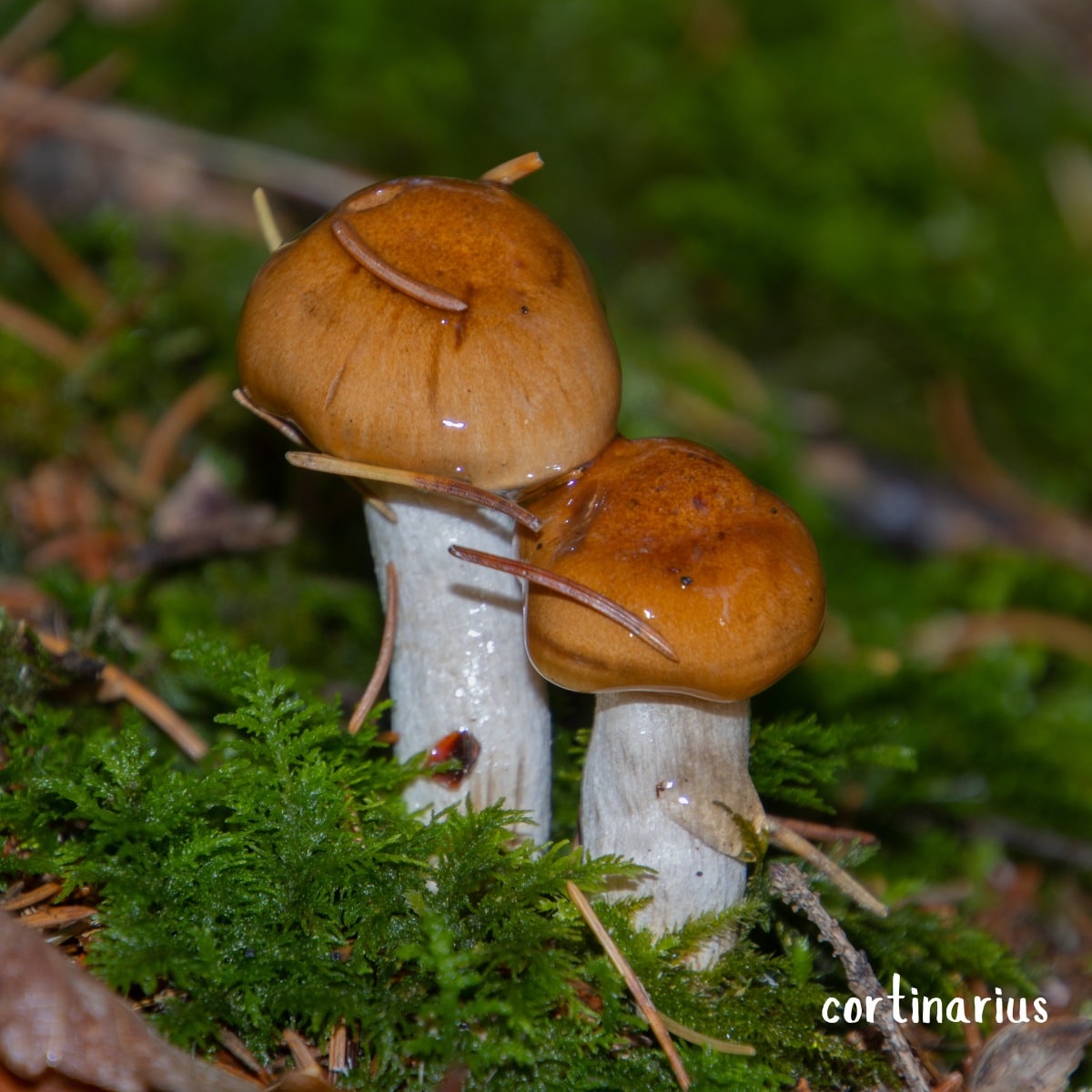
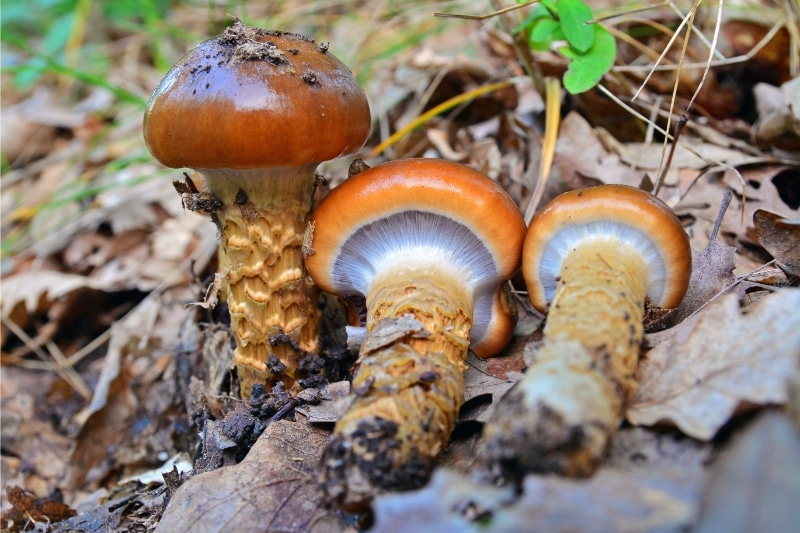
Pine Spikes (Chroogomphus species)
Chroogomphus and Gomphidius are two closely related genera of mushrooms that both belong to the family Gomphidiaceae. The Chroogomphus species used to be listed as Gomphidius until DNA and molecular analysis separated them. While they share many similarities, there are some key differences that distinguish these two groups of fungi.
Chroogomphus species, commonly known as pine spikes or spike-caps (yes, the same common name!), have cone-shaped to rounded caps that often have a distinctive pointed center. The caps typically range in color from orange-brown to reddish-brown, sometimes with a purple tinge. The gills of Chroogomphus mushrooms are decurrent (running down the stem) and are a grayish-to-purplish-gray color that darkens with age. None of the Chroogomphus species have a bright yellow stem base like most spike cap mushrooms.
Gomphidius species, on the other hand, generally have a more rounded cap shape compared to Chroogomphus. Their caps range from rounded to flat with age. The caps of spike cap mushrooms are usually more slimy. They can vary in color from white to pink, brown, or even black. Their gills are also decurrent but tend to be more widely spaced and have a whitish-to-grayish color that darkens to black as the mushroom matures.
One of the main differences between these two lies in their mycorrhizal associations. Chroogomphus species are primarily associated with pine trees. They form symbiotic relationships with their roots. In contrast, Gomphidius species have a broader host range. They can form mycorrhizal associations with various coniferous trees, including pines, firs, and larches.
The relationship between these two genera is so close that some mycologists have debated their taxonomic boundaries. In fact, some species have been reclassified between the two genera as new information has come to light.
Both Chroogomphus and Gomphidius species are edible but not particularly choice.
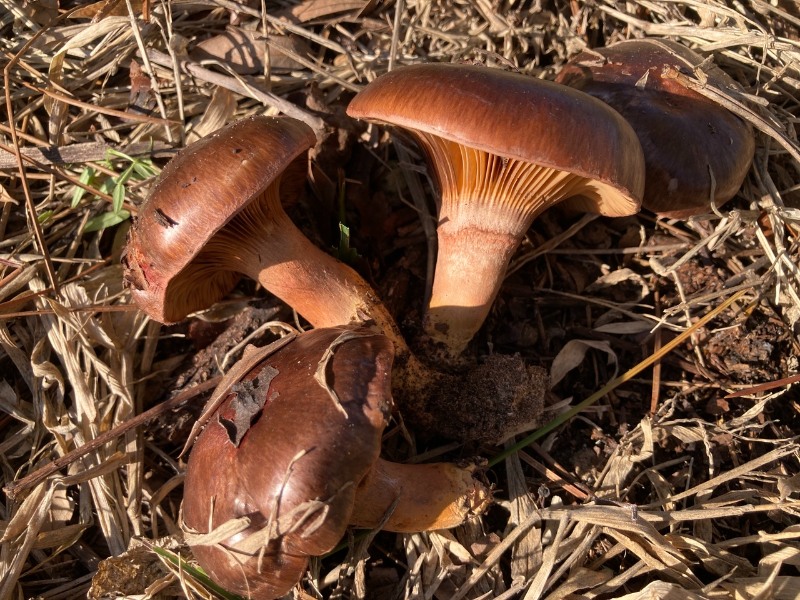
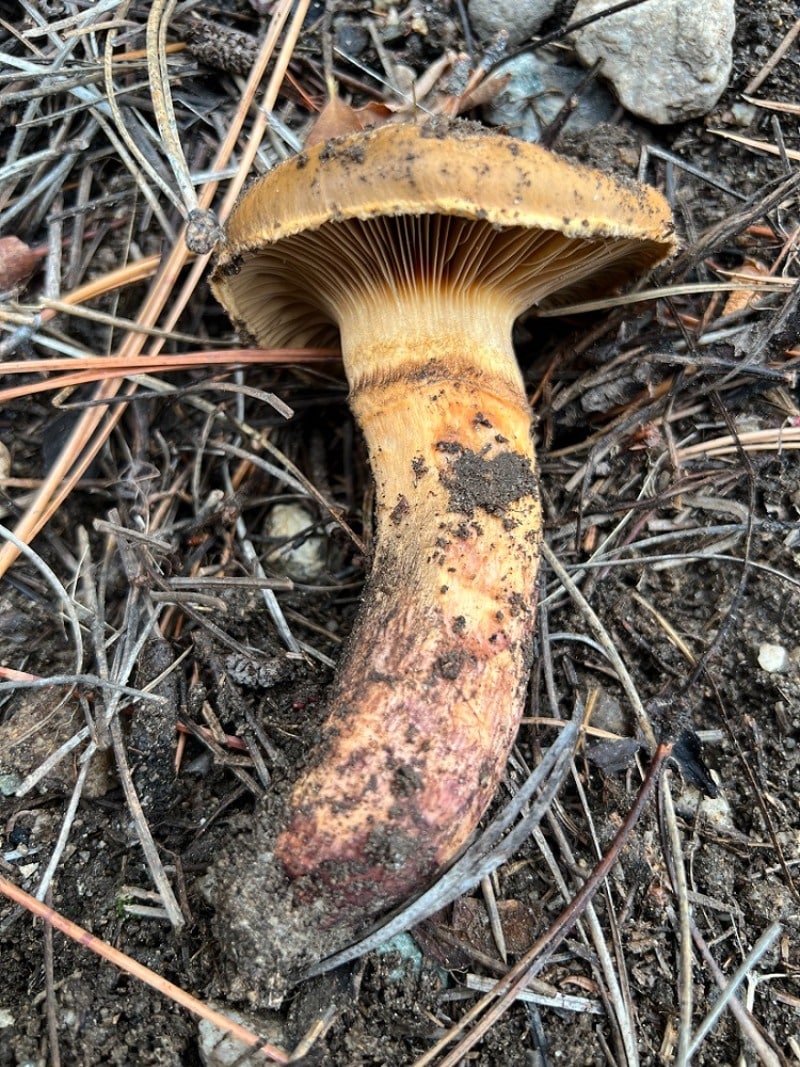
Edibility of Spike Cap Mushrooms
All spike cap mushrooms are edible, although they aren’t widely foraged. Part of this is because they aren’t super common. The main reason, though, is that they’re extremely slimy-looking and not that appealing. Most people peel off the slimy cap before preparing to make the mushrooms more palatable.
Spike cap mushrooms have a mild, slightly sweet flavor that some describe as nutty or earthy. Their taste is not as pronounced as some wild mushrooms, making them a good choice for dishes where you want a subtle mushroom flavor without overpowering other ingredients.
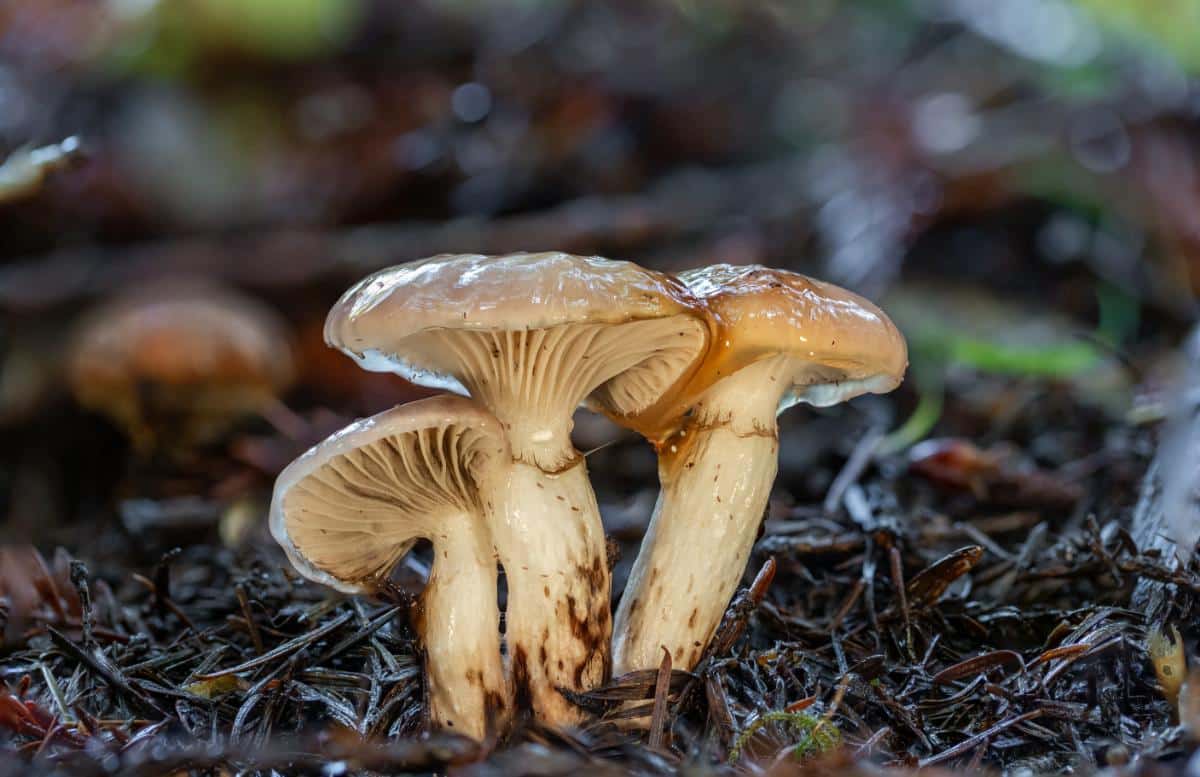
The texture of spike caps is firm and has a slightly spongy consistency. Upon cooking, they develop a meaty texture that’s somewhat chewy but not tough. The cap tends to be more tender than the stem, which can retain a bit more firmness even after cooking.
Due to their mild flavor and meaty texture, spike caps work well in a variety of dishes. They can be sautéed in butter or olive oil with garlic and herbs, which helps to enhance their natural flavors. They also hold up well in stews, soups, or pasta dishes, where they can absorb the flavors of the surrounding ingredients.
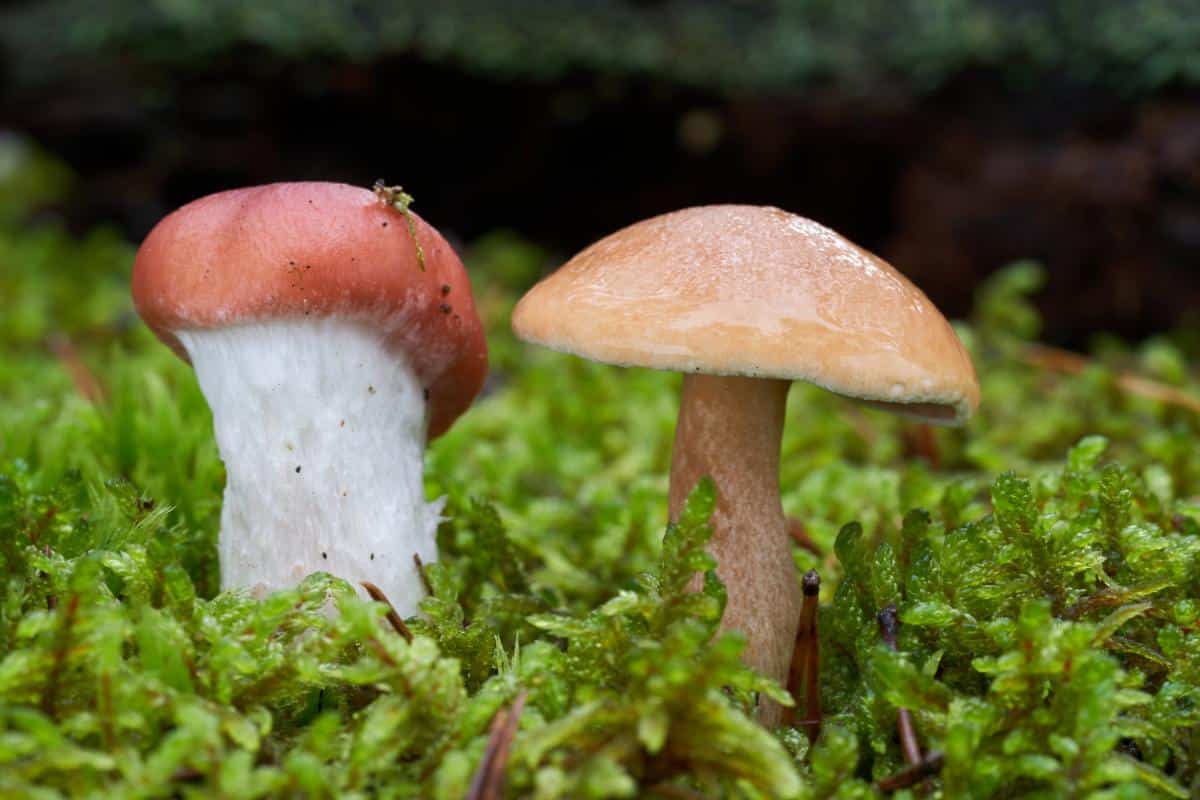
Common Questions About Spike Cap Mushrooms
Are spike cap mushrooms safe to eat?
Spike cap mushrooms are edible but are generally not foraged for the table. Their rarity, sliminess, and lack of flavor make most foragers pass them by.
How can I identify a spike cap mushroom in the wild?
Look for mushrooms with rounded caps, slimy surfaces, widely spaced gills, and a white stem at the top and yellow at the base. They’re typically found near conifer trees in North American forests.
When is the best time to find spike cap mushrooms?
The prime season for finding spike cap mushrooms is fall, typically from August through November. In some coastal areas, they may even be found during winter.
Are there any dangerous look-alikes to spike cap mushrooms?
Spike caps can be confused with some toxic species. Always exercise caution and consult experts when foraging. Some Cortinarius species, which can be toxic, look similar to spike caps.





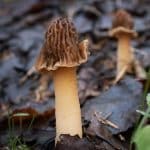
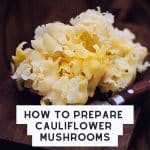
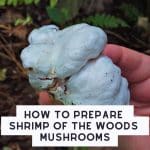
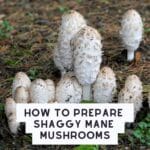
Leave a Reply